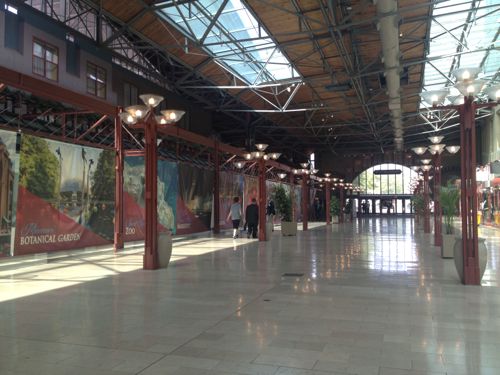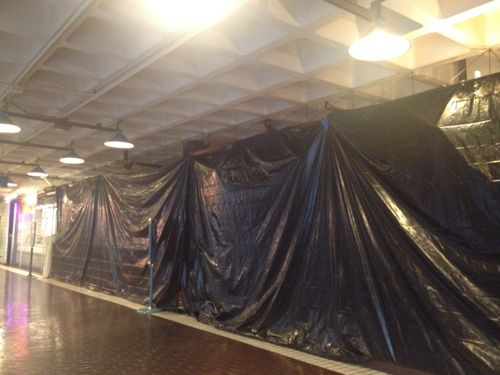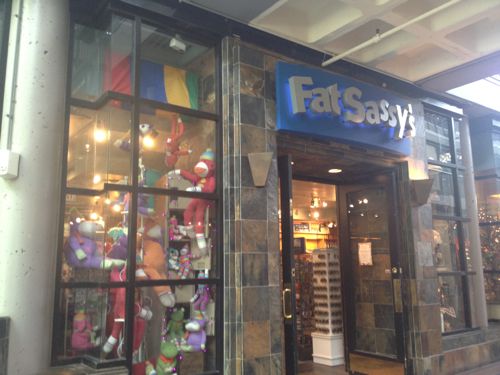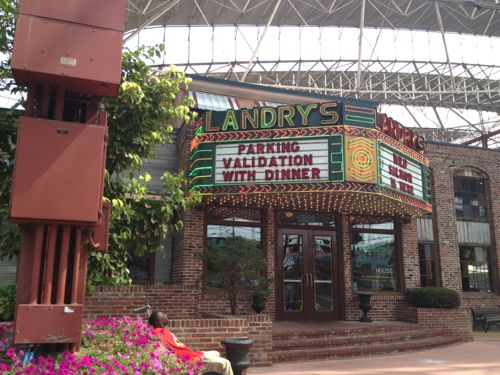Union Station “Festival Marketplace” Opened In 1985
St. Louis Union Station reopened 27 years ago today as a “festival marketplace.” Roughly translated that means cheesy mall in an old space built for some other purpose, in this case an old train shed. Actually part of the train shed is used for hotel rooms and meeting space, under the south end is parking and part is used for retail shops and food court.




In the poll last week I was pleasantly surprised by often readers had been to Union Station in the last year, I thought many more would pick “0”.
Q: How many times have you been to St. Louis Union Station in the last 12 months?
- 0 116: [54.21%]
- 1-3: 78 [36.45%]
- 4-6: 12 [5.61%]
- 7-10: 4 [1.87%]
- 13+: 3 [1.4%]
- 10-12: 1 [0.47%]
Still more than half did indicate they hadn’t been to Union Station in the last year. To my knowledge the hotel does well so hopefully someone will buy the place and rethink it once again.
— Steve Patterson
The area should be redeveloped as a transit oriented development with 500-1000 mixed income housing units. Convert part of the “festival space” into a downtown public charter school or high school sponsored by the hospitality industry. Offer high school students jobs in downtown hotels/restaurants.
“The MetroLink light rail station probably brings more people to Union Station than cars.”
The light rail station gets 3000 passengers/day. How many people use Union Station per day>
How many people use the regular trains from Chicago, KC, etc.? Why do we have that rinky-dink terminal when this magnificent structure sits one block away? Why isn’t this used as a transportation terminal including intercity buses, intracity buses; taxis; intercity trains, light rail, airline flight/baggage check in prior to taking Metrolink to Lambert, etc.?
My understanding is that Amtrak wouldn’t use a “back out station” mid-route.
Hence, the on-track multi-modal center now and, before, the crappy Amshack.
Like any (cheesy?) mall, you have to adapt/reinvent or die. The huge problem here is the need to pay to park – none of the other malls in the area have that requirement / challenge. Pay parking is less of a hurdle with a hotel, but would be a big one for charter school, especially a high school. The best answer remains a unique destination, not something with multiple competitors around the region – IKEA? An aquarium? A convention center? An indoor water park?
Yup. Nailed it. As a high school kid I remember just walking in off the street and seeing the destruction and the great hall just rotting away. A few years latter when it first opened, there was the theater in the back and that mall was bustling. I worked there two years at the Nature Company. Every night was busy. I remember when Clinton visited to campaign. We use to go to the movies often and eat at the rest. It was a place to have fun. But then the theater closed, the place became a hangout for kids with nothing better to do, the need for “malls” ended. It needs to re-invent itself, yet again. And like it or not people are going to want to drive there, and they are going to want free, guarded parking.
I’m in the camp of removing ALL parking from under the trainshed and turning it over to a new/better/different use. There’s ample parking at the lot just west, and in the Drury garage, AND in the Kiel garage. Let’s get some classic trains lined up under the shed, some seasonal options for activities (beer garden/cafe, skating rink, carnival midway, etc.), and a steady supply of concert series from the FM radio stations with HQs just to the south.
I’m in the camp of removing ALL parking from under the trainshed and turning it over to a new/better/different use. There’s ample parking at the lot just west, and in the Drury garage, AND in the Kiel garage. Let’s get some classic trains lined up under the shed, some seasonal options for activities (beer garden/cafe, skating rink, carnival midway, etc.), and a steady supply of concert series from the FM radio stations with HQs just to the south.
Maybe something like this(!):
JZ, I thought it was obvious in my first comment that the parking program would need to change. I’m suggesting building housing on the current surface lot, perhaps with structured parking if needed. No students would pay to park. There is ample parking in the area/vacant land nearby. Why don’t you like the housing/high school/hospitality industry? We talk about education. We talk about jobs. We talk about TOD. This site allows a triple bottom line. Connecting this post with the S. Broadway discussion, a plan like this “leverages” assets to create multiple bottom line positive outcomes.
Why don’t you like the housing/high school/hospitality industry…mix? That’s how it was supposed to read 🙂
It’s not that “I don’t like the housing/high school/hospitality mix” – it’s an intriguing concept – it’s just my understanding that “free” parking isn’t viable here – demand exceeds supply and land costs, while still relatively low, are too high to create more surface parking lots (as if we would want to do so).
In today’s world, especially in this region, parking IS (unfortunately) a major component in any design or land use equation. Some uses (and their users) tolerate pay parking better than others – urban office users, college students and people going to concerts, Broadway shows or pro sporting events expect to pay; most shoppers and most high school students and their parents do not – and it remains a big reason why the current use continues to struggle.
As for your concept of linking education and the hospitality industry, a much better scenario would be focusing on post-secondary education. Whether it would be SLU or Webster starting a Hospitality Management and Culinary program here or convincing Johnson & Wales to establish a campus, the odds of success increase significantly. Unfortunately, most openings for high-school-age students in the hospitality industry are at the “bottom of the food chain” and don’t require any specialized training (“You want fries with that?”).
I take it you may not have been old enough, or in town, if you fail to appreciate that in 1985…
– The entire area west of 14th street (charitably) was bombed out; Union Station paved the way for all the renovation that followed, from the RR tracks north, and west to Jefferson Ave.
– The “cheesy mall” was state-of-the-art, slicker than than anything then standing in the metro area.
– Not just the train shed, but a huge complex of ca 1900 RR infrastructure, all abandoned, inches deep in pigeon dung and a risk magnet rivalling a Goth movie, was reborn, at least in bricks-and-mortar form.
I like some of the ideas offered. Still Union Station is such a potential valuable site, it would probably be a good idea to make an attempt at defining a general development outline of the whole area, even the whole downtown or a larger area. After all, Union Station was at one time a regional structure.
For example if there were already abundant housing in the area, it may have created a customer base to support the mall (or any activity). Instead Union Station is surrounded by spread out, day time businesses. In other words people who are not likely to get in their car and drive to stop at the mall, but are too far away to walk reasonably.
Compact urban environments fed by transit, eliminating the need for an auto exist in many cities, but not St. Louis.
The future disposition of transit in St. Louis will play a big role in Union Station’s future. But for seem reason transit is not used in St. Louis to support public space nor economic development.
That, coupled with city planning that ignores Union Station as an asset sets the stage for failure.
I think I agree in some form or fashion with everybody that parking, or at least paid parking to start with, under the shed must go if the space will succeed beyond the hotel.
As for uses, what about the idea of day lighting the metrolink tunnel under Union Station/the shed and moving the current station to the other side of the street and under the shed. Then extend Clark street and its sidewalks through the shed itself. On one side, you got the ever expanding hotel and conference space and/or even the waterpark (something unique to downtown and a big fan of that idea). I understand that the hotel has being doing well and was in the midst of expanding conference space. On the other side – possibilities for everything from a destination shopping to a mixed use/residential complex. Establish a Transportation Development District to relocate the metrolink station and provide funds for shed maintenance (have to cover for loss of parking revenue somehow).
Beyond, what happen to the proposal for the hotel/Union Station being bought out and New Market Tax credits to further restoration/rebuild? Haven’t heard where that stands. Steve, do you know or have any insight?